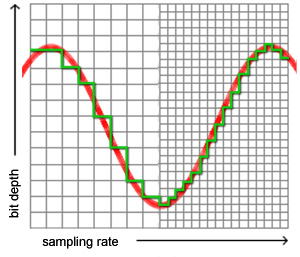24bit96 |
| |
USB HiFi and Hi-Res Audio |
24bit96 |
| |
USB HiFi and Hi-Res Audio |


Basically, this boils down to one thing: Recording and playback, or the transfer of music as information.
For example, in a vinyl record this music information exists in the form of hills and valleys in the grooves of the record. It is retrieved through a needle in the tone arm, which when running through the groove, sets the needle cantilever in motion in a magnetic field and thus induces a signal voltage. This is then sent to an amplifier and the result is an analog music signal.
In digital music this information is in the form of zeros and ones (bits). One bit can represent either a "0" or a "1". These bits are combined into a word (byte), whereby one byte contains 8 bits. For example, such a combination of bits can be a music file. This digital music file or digital music signal is sent to a digital-analog-converter (DAC), converted into an analog signal, and then sent directly to a preamplifier or analog output circuit. This occurs, for example, in a CD player from the music CD to an internal or external DAC, or when a computer is used, from the hard disk via a USB connection directly to the DAC.
This gets interesting when we consider the write and read procedure of such a music file, as this is where we can quickly see the advantages of digital high-end use of computers.
| Word Length (Bit) = Resolution |
Dynamic Range | Resultant Gradations |
|---|---|---|
| 12 bit | 72 dB | 4.096 |
| 16 bit | 96 dB | 65.536 |
| 24 bit | 144 dB | 16.777.216 |
| 32 bit | 192 dB | 4.294.967.296 |
In plain language, this means that the denser the digital information is, the closer the "digital" signal (green) approaches the analog signal (red):

For example, if you have digital music on CD in 16bit/44.1kHz, this corresponds to a dynamic range of 96dB with 65,536 gradations. However, the music is rarely burned on the CD at these rates, because previously recording was done at only 16bit. Reserves for recording levels, losses at mastering, etc., reduce the signal even further.
Nowadays, however, recordings are made at 24bit/192kHz (partly also at 32bit/384kHz), which means that the word length is significantly greater (and thus has a greater dynamic range), and the sampling frequency is higher, thus increasing the bandwidth. And this is also the advantage of digital audio - if you have an audio file with a high resolution, then there is a "lot more music in it" so that all that needs to be done is to send this file via a USB connection from a music server to a high quality DAC and to convert it into an analog signal. The music lover therefore has in fact access to more information and dynamics, and this serves as the basis for high quality audio through use of a computer.
Finally, assuming a very good output signal, we can say that a higher word length, combined with a high sampling rate corresponding to appropriate gradation, will guarantee an excellent audio signal. Keep in mind, that the increase in information content that results from a higher word length is exponential, so that differences, say, between 16 bit and 24 bit recordings, could be heard only on very good equipment.
Thus, digital audio again offers a wide range to squeeze the last bit of information out of the music, and the DIY USB Audio Computer with a very good DAC becomes an important link in the audiophile's setup for listening to bitperfect audio.